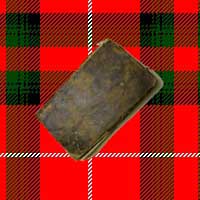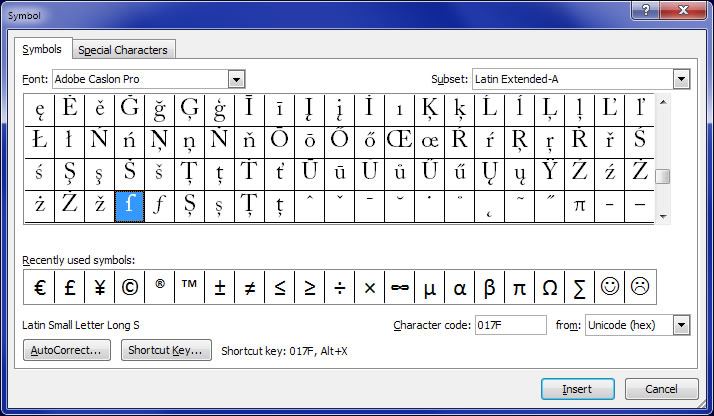
Ascanius; or, the Young Adventurer
Bestselling book of the 18th and 19th centuries
home
|
Reading and understanding 18th century texts |
|
Many 18th century texts between 1735 and 1800 were printed using the font Caslon designed by William Caslon (1692-1766), sometime around 1722. Texts can be difficult for modern readers not least for the common use of the long s: The long s looks like a letter "f" but without the right side crossbar i.e. ſ You will also find the following ligatures. Spelling is often wrong and can vary many times in the same document, especially with personal and place names. I have seen MacDonald spelled five different ways in one paragraph. Dictionaries were not commonly used until Samuel Johnson published his in 1755 (Johnson's Dictionary, 6th Edition, Volume 1 and Volume 2). Also useful might be An etymological dictionary of the Scottish language Volumes One, Two, and Four. The AE dipthong (ligature) Æ is also commonly used as in the name Æneas. Similarly the lower case oe (œ), and ae (æ) dipthong. For a reference on how to put these in HTML documents see: Additional named entities for HTML W3C Working Draft 25-Nov-96<!ENTITY AElig CDATA "Æ" -- capital AE diphthong (ligature) --> Æ <!ENTITY oelig CDATA "œ" -- latin small ligature oe, U0153 ISOlat2 --> œ <!ENTITY aelig CDATA "æ" -- small ae diphthong (ligature) --> æ To insert the ſ character in MS Word, if the font supports it, you will find long s in the Latin Extended-A part of the font set:
This can be inserted manually using the key combination 017F followed by Alt+X (if you use it regularly, you will probably assign it a shortcut key combination such as Alt+Ctrl+S). In the transcriptions, I have replaced all of the long s characters as it's just too confusing. Except in A True and Full ACCOUNT of the late Bloody and Desperate Battle fought at Gladſmuir. This account was reprinted almost verbatim in the Scots Magazine of September 1745 and in History of the transactions in Scotland, in the years 1715-16, and 1745-46 Volume II by George Charles. The original formatting has been preserved (including long s and all ligatures). A free version of the Caslon font is Wyld which includes Word macros to create ligatures. The Medieval Unicode Font Initiative fonts Andron and Palemonas contain ligatures for , st, and many others.
Please note Unicode does not have a ct ligature defined but does have others such as st,ff,fi,fl,ffi,ffl, and ſt. You can make the ligature using the Andron Scriptor Web font or Adobe Garamond Pro. If you are going to create PDF documents, make sure you unclick the option to "Bitmap fonts that can't be embedded". Sometimes this works and sometimes it doesn't so if at first you don't succeed ... Try converting the Word document by right-clicking and choose convert to PDF.
Other confusing words are the old English forms for, the = ye (not to be confused with the Middle English pronoun ye which meant you.) There are also many superscripted titles such as Lord (Ld), Mr, Genl, Capt, and the always confusing abbreviation for John which is Jno. Finally, the £ Pound sterling is often shown as the letter "l." i.e. 500l. meaning £500. The use of blanks in names was commonly used in 18th century newspapers to avoid being sued. Commonly, Charles Edward would be P— which, if you were a Jacobite, would mean Prince, or, to a Whig, it would mean Pretender. Old English or Blackletter fonts are commonly used in texts of this period i.e. in The London Gazette where it is: Published by Authority This should look like the image below
This font may not appear in your downloaded PDF files even though they have been embedded. Try clicking refresh (Ctrl+R) on your browser. In transcribing these texts I have tried not to mess too much with the original spellings except in the case where this is an obvious misprint or it results in confusion for the reader. For placenames I have added links to the actual places in Google Maps using my map of the Jacobite Rebellion. These links are automatically populated by my Historical Timeline software. For an example see Itinerary of Prince Charles Edward Stuart from his landing in Scotland July 1745 to his departure in September 1746. By Robert Forbes and Walter Biggar Blaikie (WBB). When reading old texts you will find many references pointing to earlier references using the abbreviation Ibid. (Latin, short for ibidem, meaning the same place) which is the term used to provide an endnote or footnote citation or reference for a source that was cited in the preceding endnote or footnote. It is similar in meaning to idem (meaning something that has been mentioned previously; the same) abbreviated Id., which is commonly used in legal citation. To find the ibid. source, one has to look at the reference just before it. Other forms of citation might refer to supra (Latin for "above") is an academic and legal citation signal used when a writer desires to refer a reader to an earlier-cited authority. For example, an author wanting to refer to a source in his or her third footnote would cite: See supra note 3. Or for text in that note: See supra text accompanying note 3. Vide supra means see above. Also infra is Latin for below. Vide infra means see below. Op. cit. (Latin, short for "opus citatum"/"opere citato", meaning "the work cited/from the cited work") is the term used to provide an endnote or footnote citation to refer the reader to an earlier citation by the same author. To find the op. cit. source, one has to look at the previous footnotes or general references section to find the relevant source work. Contrast: ibid, referring to the last cited source, and supra, meaning cited (with details of the source) above. Also loc. cit. ("in the place cited"), now rarely used. You will often see transcibed words marked sic which is a Latin word meaning "thus," "so," "as such," or "in such a manner." It is used when writing quoted material to indicate that an incorrect or unusual spelling, phrase, punctuation or meaning in the quote has been reproduced verbatim from the original and is not a transcription error (i.e. it appeared thus in the original). It is normally placed within the quoted material, in square brackets and often italicized [sic]. Alternatively, it can appear after the quote in parentheses (round brackets) (sic). Genealogicaldsp: (Latin, decessit sine prole) died without issue Miscellaneous Latin Terms&c:(Latin, et cætera) and also DegreesAB: Bachelor of Arts Also see 18th Century Units of Measure for a description of commonly used Scottish and English measures. Finally, even more difficult for English speakers is understanding 18th Century French texts and this may help. If you want to experiment with new features in Firefox, then try these two pages that demonstrate ligature substitution, and also Drag and Drop. Finally, there is a section on sailing ships and nautical terms. Date Marks are often found in Scottish legal documents and are explained here:
Over the years I have collected a Google Books reference library related to the Jacobite cause. Instead of searching all of Google Books for a word or phrase, you will get very high quality search results by just searching this library. For example this will search My Library for any book containing the word "Clifton". Loading
|



